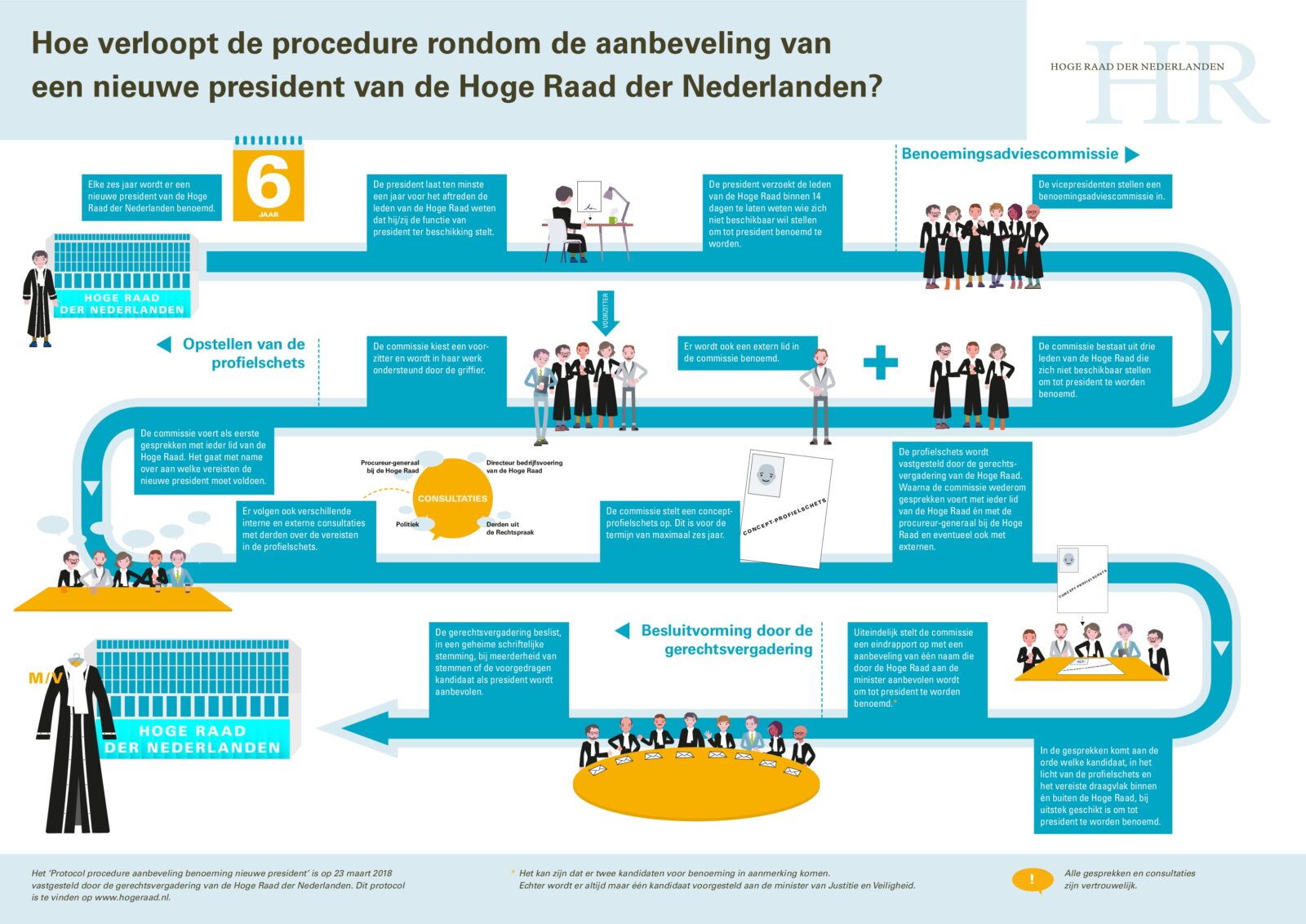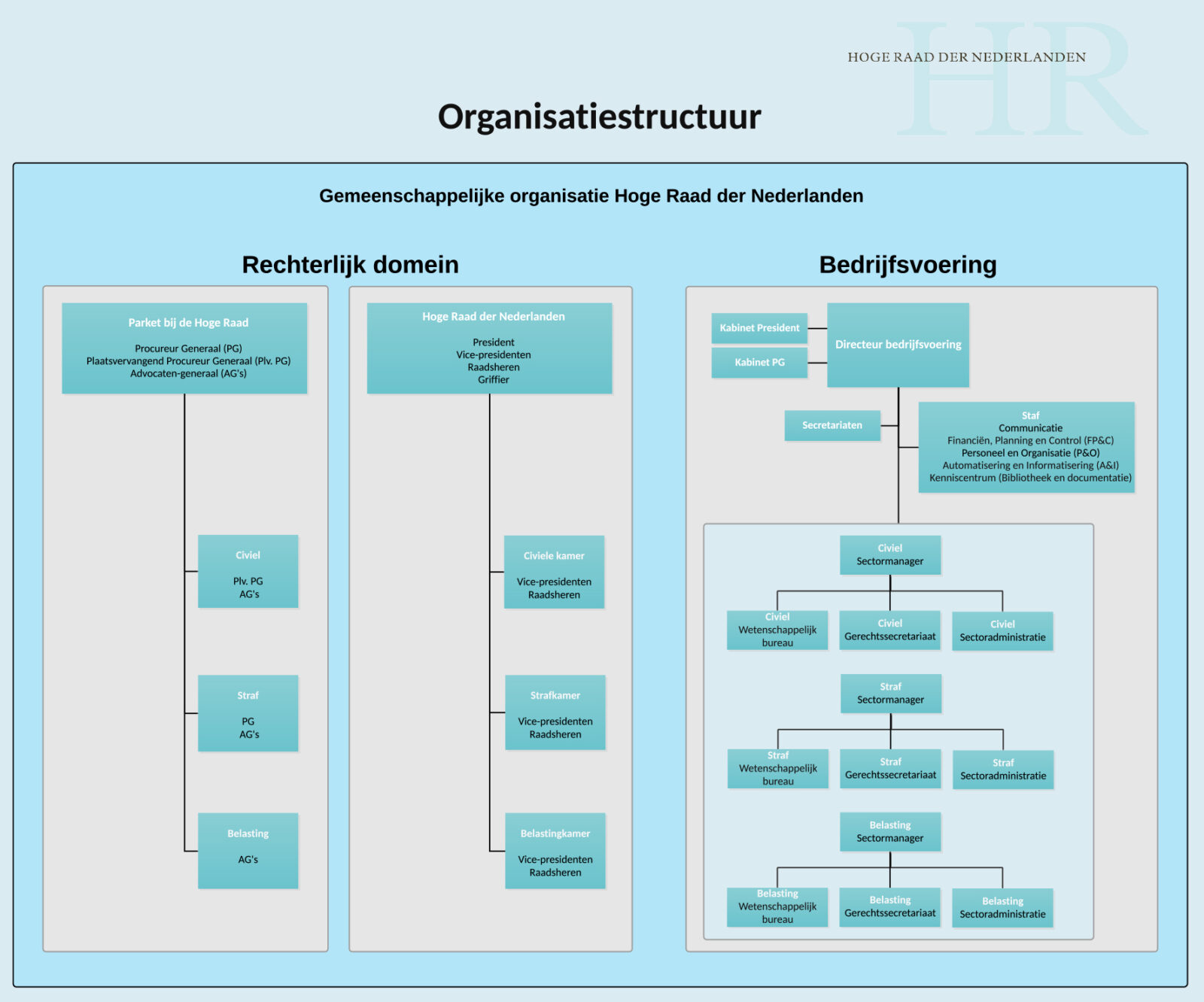President and Procurator General
In the autumn of 2020 a new president, Dineke de Groot, took office. She succeeded Maarten Feteris, who was president from 1 November 2014 to 1 November 2020. At a hearing on 29 October 2020 the Supreme Court took leave of Maarten Feteris as president. He will continue his activities as justice in the Tax Division. In his farewell speech (Dutch text of speech), the departing president looked back on his term of office. Communication in comprehensible language was one of the subjects he touched upon. He said that using plain language in judgments establishes a connection with society. As highest court, the Supreme Court regularly makes decisions that are of societal importance, that must be enforced in society and must be understood and respected by the people concerned. Upon stepping down, Maarten Feteris was appointed a Commander in the Order of Orange-Nassau, with the decoration being presented by the Minister for Legal Protection.

The president is appointed from among the sitting members of the Supreme Court. The Court has the right to recommend a candidate to the government, which makes the appointment. In 2018 the Court established a protocol governing the recommendation procedure. In accordance with the protocol, a recommendation was adopted on 5 March 2020 at a court meeting. The Supreme Court issued updates at different points in the procedure. For example, in 2019 an infographic was posted on the website detailing the procedure for recommending a candidate for the post of president.

Once the profile had been adopted it was also published. The appointment was widely publicised following the cabinet’s decision and after the new president had been sworn in by the King.
NEWS ITEM
Dineke de Groot nieuwe president Hoge Raad (Dutch news item)
NEWS ITEM
Dineke de Groot beëdigd tot president Hoge Raad (Dutch news item)
Partly in view of the coronavirus restrictions, Dineke de Groot’s inauguration on 2 November 2020 was live-streamed so that a broad section of the public could follow the ceremony and hear her inaugural address. Her speech, entitled ‘Trust in the judicial system’, was published on the Supreme Court website, and was thus widely accessible.

Together with the Director of Operations, the President and the Procurator General form the executive board of the Supreme Court. On 1 September 2020 Vera de Witte was appointed as the new Director of Operations.
The president is the highest-ranking judicial officer responsible for the administration of justice, while the Procurator General is charged with other tasks. Reactions from the public have often shown that the president is thought to have powers that are not in fact granted to this officeholder by the law. For example, the president cannot intervene in individual situations, nor can they reprimand judges or courts. Within the Supreme Court, the president is ‘first among equals’ and exercises functional authority in relation to colleagues, which means that the president is empowered to make decisions or recommendations regarding legal status as specified by law. The president may not make such decisions regarding the members of the Procurator General’s Office, where the Procurator General exercises functional authority.
The Supreme Court and the Procurator General are two separate institutions enshrined in law between which there is no relationship of authority. The Procurator General is mentioned separately from the Supreme Court in the Constitution and has a specific chapter (Chapter 3) in the Judiciary (Organisation) Act. Both the president and the Procurator General are appointed for life. However, it has been customary for some time for the president to step down after around six years to make way for a new president. In some areas, the president and Procurator General act as equals, for example in advising on legislative proposals and in their contacts with other bodies within the three branches of government, such as Parliament, the Ministry of Justice and Security and the Council for the Judiciary.
The Supreme Court’s complaints procedure states that anyone can lodge a complaint with the president concerning the way in which they have been treated in specific circumstances by the Supreme Court, one of its members or its clerk. However, it is not possible to complain about a decision of the Court, the way in which it was reached or decisions of a procedural nature. In other words, in handling complaints, the president does not venture into the judicial domain.
The president is also the standard bearer of the Supreme Court, representing the Supreme Court as an institution and sometimes also the judicial system as a whole. That task is not limited to the Netherlands: the president represents the Court abroad, for example as a member of international networks of judges, such as the Network of the Presidents of the Supreme Judicial Courts of the European Union. Since international law and comparative law have become increasingly important to the way Court carries out its tasks, it is vital for the Court to be represented in such networks and to maintain good contacts with supranational courts, such as the Court of Justice of the European Union and the European Court of Human Rights.
The Procurator General is the head of the Office of the Procurator General at the Supreme Court, which consists of a deputy procurator general and the advocates general. Its primary task is to provide the Supreme Court with legal advice. The scholarly nature of these ‘advisory opinions’ means they are of great value to the Court in preparing and making its decisions. These opinions are of a compelling nature, but not binding: the Supreme Court is free to depart from their conclusions.
In addition to providing advisory opinions in cassation proceedings, the Procurator General has a number of special tasks laid down by or pursuant to the law. These comprise applications for retrial in criminal proceedings and for cassation in the interests of the development or uniform interpretation and application of the law; handling complaints about members of the judiciary; the suspension and dismissal of members of the judiciary; prosecuting members of government and parliament; overseeing the Public Prosecution Service; and supervising personal data processing by all of the country’s courts and by the Procurator General’s Office at the Supreme Court (under the General Data Protection Regulation). For more information about these special tasks, please see the section on the Procurator General’s Office.
Some of the Procurator General’s tasks also provide a gateway to the Supreme Court. This applies for example in relation to applications for cassation in the interests of the development or uniform interpretation and application of the law. The lower courts sometimes come to different conclusions and consequently hand down conflicting judgments concerning a particular legal issue, which may lead to inequality before the law. Such cases are not always presented to the Supreme Court in the normal way. For example, the parties involved may decide not to pursue the matter further or appeal in cassation may not even be an option. In both situations, the Supreme Court will not generally have the opportunity to give an opinion on the legal question at issue. However, if the Procurator General finds it to be in the public interest for the Supreme Court to consider the matter, they can lodge an application for this special form of cassation. This instrument enables the Procurator General to obtain a decision from the Supreme Court on a legal question that must be answered in the interests of the uniformity of the law. The development of the law may also be at issue. In that case, the aim of the Procurator General’s application is to enable the Supreme Court to direct the way in which the law is developing in a specific area. One example would be the Court’s 2020 judgment on the subject of euthanasia for people with advanced dementia, prompted by such an application from the Procurator General. The importance of cassation is thus not only to be found in the correct application of the law in the case at issue but also in the provision of judicial conclusions that take account of other cases and may possibly lead to the development of new law (judicial lawmaking). Every year the Procurator General receives dozens of requests to lodge such an application. Only a limited number of these requests actually lead to an application. In general, the Procurator General will only consider such a request if it concerns a clear, well defined question of law on which the answer of the Supreme Court is important for the uniformity or the development of the law.
Other examples of cases which cannot be presented to the Supreme Court without the intervention of the Procurator General include applications regarding the suspension or dismissal of members of the judiciary, those prompted by a complaint about a judge in the performance of their duties, and criminal prosecutions of members of government or parliament following instructions issued in the form of a royal decree or a decision of the House of Representatives. Due to their position and role, the Procurator General has the sole power and sometimes the obligation to bring matters before the Supreme Court.
The Supreme Court, the Procurator General and the latter’s Office are assisted by the same support services and are housed in the same building. These services, which together constitute the Operations Directorate, are headed by the Director of Operations and comprise a research and an administrative section that are involved in the handling of cases, and a number of staff units.
The Supreme Court, the Procurator General, the latter’s Office and the Operations Directorate together form a single organisation. The constitution of this organisation provides for an executive and a general management board. As stated earlier, the president, the Procurator General and the Director of Operations form the executive board, and are also members of the general management board. The president is the chair of both boards, which handle matters relating to shared operational management. Matters relating to the administration of justice are dealt with by the Supreme Court or the Procurator General’s Office.
